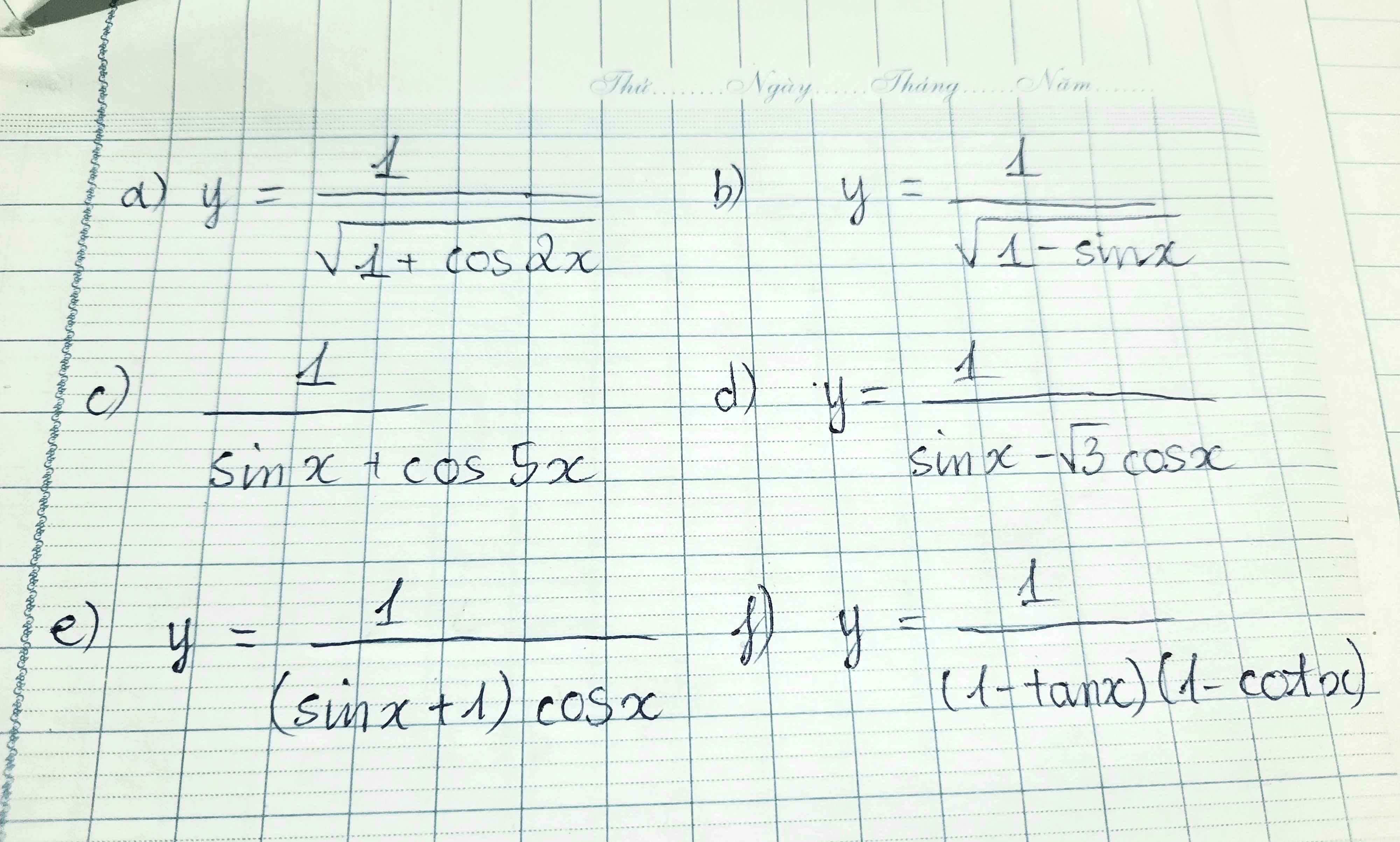GIÚP MÌNH VỚI, MÌNH CẦN GẤP Ạ
Tìm tập xác định của hàm số
Hãy nhập câu hỏi của bạn vào đây, nếu là tài khoản VIP, bạn sẽ được ưu tiên trả lời.


\(y=\dfrac{cos3x}{1-sinx}+tanx=\dfrac{cos3x}{1-sinx}+\dfrac{sinx}{cosx}\)
Hàm số xác định khi \(\left\{{}\begin{matrix}1-sinx\ne0\\cosx\ne0\end{matrix}\right.\Leftrightarrow\left\{{}\begin{matrix}sinx\ne1\\cosx\ne0\end{matrix}\right.\Leftrightarrow x\ne\dfrac{\pi}{2}+k\pi\)

\(b,\Leftrightarrow x=3;y=0\Leftrightarrow9-1+a=0\Leftrightarrow a=-8\\ \Leftrightarrow y=3x-1-8=3x-9\\ c,\text{PT hoành độ giao điểm: }3x-3=3x-9\Leftrightarrow0x=-6\Leftrightarrow x\in\varnothing\)
Vậy 2 đt trên không cắt nhau

a.
\(y'=4x^3-4x=4x\left(x^2-1\right)=0\Rightarrow\left[{}\begin{matrix}x=0\\x=-1\\x=1\end{matrix}\right.\)
Dấu y' trên trục số:

Hàm đồng biến trên các khoảng \(\left(-1;0\right)\) và \(\left(1;+\infty\right)\)
Hàm nghịch biến trên các khoảng \(\left(-\infty;-1\right)\) và \(\left(0;1\right)\)
b.
\(y'=x^2+6x-7=0\Rightarrow\left[{}\begin{matrix}x=-7\\x=1\\\end{matrix}\right.\)
Dấu của y' trên trục số:

Hàm đồng biến trên các khoảng \(\left(-\infty;-7\right)\) và \(\left(1;+\infty\right)\)
Hàm nghịch biến trên \(\left(-7;1\right)\)


a) Hàm số xđ <=> \(1+cos2x>0\) \(\Leftrightarrow cos2x\ne-1\) \(\Leftrightarrow\)\(2cos^2x-1\ne-1\)
\(\Leftrightarrow cosx\ne0\) \(\Leftrightarrow x\ne\dfrac{\pi}{2}+k\pi\left(k\in Z\right)\)
b)Hàm số xđ <=> \(1-sinx>0\) \(\Leftrightarrow sinx\ne1\) \(\Leftrightarrow x\ne\dfrac{\pi}{2}+k2\pi\left(k\in Z\right)\)
c) Hàm số xđ <=> \(sinx+cos5x\ne0\)
\(\Leftrightarrow sinx\ne-cos5x\)
\(\Leftrightarrow cos\left(\dfrac{\pi}{2}-x\right)\ne cos\left(\pi-5x\right)\)
\(\Leftrightarrow\left\{{}\begin{matrix}\dfrac{\pi}{2}-x\ne\pi-5x+k2\pi\\\dfrac{\pi}{2}-x\ne-\pi+5x+k2\pi\end{matrix}\right.\) (\(k\in Z\))
\(\Leftrightarrow\left\{{}\begin{matrix}x\ne\dfrac{\pi}{8}+\dfrac{k\pi}{2}\\x\ne\dfrac{\pi}{4}-\dfrac{k\pi}{3}\end{matrix}\right.\)(\(k\in Z\))
d) Hàm số xđ <=> \(sinx-\sqrt{3}cosx\ne0\)
\(\Leftrightarrow2.sin\left(x-\dfrac{\pi}{3}\right)\ne0\) \(\Leftrightarrow x\ne\dfrac{\pi}{3}+k\pi\left(k\in Z\right)\)
e) Hàm số xđ <=> \(\left(sinx+1\right).cosx\ne0\)
\(\Leftrightarrow\left\{{}\begin{matrix}sinx\ne-1\\cosx\ne0\end{matrix}\right.\) \(\Leftrightarrow\left\{{}\begin{matrix}x\ne-\dfrac{\pi}{2}+k2\pi\\x\ne\dfrac{\pi}{2}+k\pi\end{matrix}\right.\) (\(k\in Z\)) \(\Rightarrow x\ne\dfrac{\pi}{2}+k\pi\) (Hai họ nghiệm trùng nhau nên e tổng hợp lại, e nghĩ thế)
f) Hàm số xđ <=> \(\left\{{}\begin{matrix}\left(1-tanx\right)\left(1-cotx\right)\ne0\\sinx\ne0\\cosx\ne0\end{matrix}\right.\) \(\Leftrightarrow\left\{{}\begin{matrix}tanx\ne1\\cotx\ne1\\sinx.cosx\ne0\end{matrix}\right.\)
\(\Leftrightarrow\left\{{}\begin{matrix}sinx\ne cosx\\\dfrac{1}{2}.sin2x\ne0\end{matrix}\right.\)\(\Leftrightarrow\left\{{}\begin{matrix}sinx\ne sin\left(\dfrac{\pi}{2}-x\right)\\2x\ne k\pi\end{matrix}\right.\) \(\Leftrightarrow\left\{{}\begin{matrix}x\ne\dfrac{\pi}{2}-x+k2\pi\\x\ne\dfrac{\pi}{2}+x+k2\pi\\x\ne\dfrac{k\pi}{2}\end{matrix}\right.\)(\(k\in Z\))
\(\Leftrightarrow\left\{{}\begin{matrix}x\ne\dfrac{\pi}{4}+k\pi\\0\ne\dfrac{\pi}{2}+k2\pi\\x\ne\dfrac{k\pi}{2}\end{matrix}\right.\)(\(k\in Z\)) \(\Leftrightarrow\left\{{}\begin{matrix}x\ne\dfrac{\pi}{4}+k\pi\\x\ne\dfrac{k\pi}{2}\end{matrix}\right.\)(\(k\in Z\))